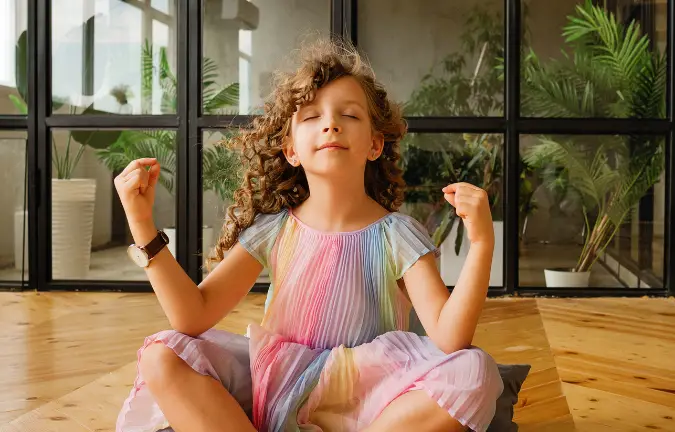
5 Yoga for Kids
Yoga for Kids: A Path to Health and Happiness, Yoga isn’t just for adults—it can be incredibly beneficial for children too. With its mix of movement, breathing techniques, and mindfulness, yoga helps kids build both physical and mental strength while having fun. Here’s why yoga is great for kids and how to introduce it into their lives.
Table of Contents
Benefits of Yoga for Kids
- Physical Fitness
Yoga improves strength, flexibility, balance, and coordination, which are essential for kids as they grow and explore their abilities. - Focus and Concentration
Through mindfulness and poses that require attention, yoga helps kids learn how to stay focused, a skill that benefits them in school and daily life. - Stress Relief
Kids experience stress too, whether from schoolwork or social challenges. Yoga provides them with tools to relax, manage emotions, and feel more in control. - Boosts Self-Esteem
Successfully learning and holding poses helps children build confidence and feel proud of their efforts. - Improved Sleep
Gentle stretches and breathing exercises before bed can help kids relax and get better rest.
5 Yoga for Kids

Yoga for kid
1. Tree Pose (Vrikshasana)
Steps:
- Stand tall with feet together.
- Shift weight onto one foot and place the sole of the other foot on the inner thigh or calf.
- Raise arms overhead like branches and balance.
Benefits:
- Improves balance and coordination.
- Enhances focus and concentration.
2. Cat-Cow Pose (Marjaryasana-Bitilasana)
Steps:
- Start on hands and knees.
- Arch the back upward like a cat and tuck the chin.
- Lower the belly while lifting the head and tailbone like a cow. Repeat slowly.
Benefits:
- Strengthens the spine and improves posture.
- Relieves tension in the back and neck.
3. Butterfly Pose (Baddha Konasana)
Steps:
- Sit on the floor with your feet together, knees bent outward.
- Hold your feet with your hands and gently flap your knees like butterfly wings.
Benefits:
- Stretches the inner thighs and hips.
- Improves flexibility and promotes relaxation.
4. Downward Dog (Adho Mukha Svanasana)
Steps:
- Start on hands and knees, then lift hips upward to form an inverted “V.”
- Keep hands and feet grounded, and let the head relax between the arms.
Benefits:
- Strengthens arms, legs, and core.
- Boosts energy and stretches the entire body.
5. Child’s Pose (Balasana)
Steps:
- Sit back on heels and stretch arms forward while lowering the forehead to the floor.
- Relax the entire body and breathe deeply.
Benefits:
- Promotes relaxation and calms the mind.
- Gently stretches the back, hips, and thighs.
These poses are simple, engaging, and offer great physical and mental benefits for kids, making yoga a joyful and healthy activity!
Making Yoga Fun for Kids
Yoga for kids is all about blending movement with creativity to create an enjoyable and engaging experience. Unlike adult yoga, which often focuses on precise poses and discipline, yoga for children thrives on imagination and play. To make it fun, parents and teachers can incorporate storytelling, animal poses, or even partner activities into the practice. For example, a child in Tree Pose can imagine being a swaying tree in a forest, while Downward Dog can transform them into a playful puppy.
Adding music or colorful props like mats, scarves, or balls can also capture kids’ attention and keep them motivated. Games like “yoga freeze,” where children hold a pose when the music stops, make the practice feel less structured and more like play. Integrating yoga-themed stories or breathing exercises can help kids connect with the practice on a deeper level without even realizing they’re working on mindfulness.
Yoga sessions for kids should be short, flexible, and packed with fun elements. Encouraging kids to name their favorite poses or create their own helps them feel involved and confident. Remember, the goal isn’t perfection but exploration and enjoyment. With the right approach, yoga can be an enriching activity that kids look forward to, offering both physical benefits and tools for emotional growth.
Yoga for All Ages
Yoga for kids is not about mastering poses but embracing movement, creativity, and mindfulness. It’s a playful way for children to connect with their bodies while enhancing strength, flexibility, and balance. Beyond the physical benefits, yoga nurtures emotional well-being, helping kids develop focus, calmness, and confidence. Practiced at home or in groups, it fosters a sense of community and joy. By making yoga part of their routine, children can build resilience and self-awareness, setting the foundation for a healthier and more balanced life. Yoga truly offers kids a fun and meaningful way to grow physically and emotionally.
References
“7 Benefits of Yoga for Young Kids” by Arizona Early Childhood: This article outlines how yoga helps children manage anxiety, improve emotional regulation, boost self-esteem, and more.
“Yoga for Kids: Benefits and Poses” by Cleveland Clinic Health Essentials: This resource highlights the advantages of yoga for children, including improved concentration, emotional regulation, and physical fitness.
Cleveland Clinic Health Essentials
“More than just a game: Yoga for school-age children” by Harvard Health: This article discusses how yoga improves balance, strength, endurance, and aerobic capacity in children, along with psychological benefits.
“11 Benefits of Yoga for Kids” by Parents Magazine: This piece explores various benefits of yoga for children, such as stress reduction, improved academic performance, and boosted confidence.
“Yoga for Kids: Simple Poses to Enhance Balance and Coordination” by Connect Pediatric Therapy: This resource provides simple yoga poses designed to enhance balance and coordination in children.
